Latest Research Trends in Fall Detection and Prevention Using Machine Learning: A Systematic Review
Abstract
:1. Introduction
- It provides an overview of the fall detection and prevention systems using wearables and non-wearables.
- It elaborates on the frequently used ML algorithms in fall detection and prevention.
- It provides a detailed analysis of the recent state-of-the-art studies. The analysis covers the dataset, participants, ML algorithms, acquisition sensors, and their placements.
- It evaluates performance parameters such as accuracy, sensitivity, and specificity for different combinations of ML algorithms, sensors, and placements.
- It provides a detailed discussion on the latest trends in fall detection and prevention systems along with the future directions.
2. Fall Detection and Prevention Systems
2.1. Non-Wearable Systems
2.2. Wearable Systems
2.3. System Overview
3. Machine Learning Algorithms
3.1. Support Vector Machine (SVM)
3.2. Artificial Neural Network (ANN)
3.3. Random Forest (RF)
3.4. k-Nearest Neighbors (kNN)
3.5. k-Means
3.6. Linear Discriminant Analysis (LDA)
3.7. Naive Bayes
4. Literature Review
- Identification
- Screening
- Inclusion
- The paper is published after 2010.
- The publishing venue is a Journal or Conference.
- The study is using ML for fall detection or prevention.
- The study is using a detailed methodology and results.
5. Analysis of Fall Detection and Prevention Schemes
5.1. Data Collection
Participants Age
5.2. Devices for Data Acquisition
5.3. Sensors Placement
5.4. Number of Sensors
5.5. ML Algorithms
5.6. Performance Analysis
6. Discussion
- Energy Efficiency: A wearable-based system can be used in a more realistic environment. However, these sensors are tiny with limited lifetime and processing power. Therefore, energy efficiency algorithms [107,108] are required to improve the feasibility of such a system [109]. The use of an energy harvester can be another potential solution to enhance the significance of the system. Fog or edge computing [110,111] is also an exciting solution to mitigate the impact of resource-hungry ML algorithms. The processing at the edge can eliminate the computational load at the sensors. Therefore, it is optimal for designing a fall detection application. In contrast, edge computing introduces the delays that make it unfit for fall prevention applications.
- Datasets: Most studies created a dataset for their experiments. However, the datasets were mainly small and consisted of healthy subjects. Extensive datasets improve the classification accuracy. Therefore, it is essential to generate large datasets, primarily consisting of elderly data. More real datasets should be created, as current datasets includes samples from ages under 40, which are physically different from people over 60. The data fusion of custom data with public datasets can generate more accurate results. The Generative Adversarial Network (GAN) [112] is also an interesting choice to enhance the datasets.
- Context Awareness: Context awareness is another exciting future direction. Usually, fall prevention applications rely on gait. However, the gait of an individual varies from surface to surface [113]. For example, the gait of a person would be different on the standard floor and sand. Therefore, there is a need for a context-aware system that incorporates this problem and minimizes false alarms.
- Sensor Fusion: Sensor fusion works on the principle of combining the data from multiple sensors to make a decision [114]. It helps in reducing the uncertainties in the data. Therefore, sensor fusion can be a potential future direction for fall detection and prevention systems.
- Wearable Design: Generally, users will be wearing the sensor-based solution for longer intervals [115]. Sometimes, a system consists of more than one sensor and electrodes. This makes the design of a user-friendly system an interesting future direction. During our analysis, this aspect was totally neglected, which questions the real-life applicability of the system.
7. Conclusions
Author Contributions
Funding
Institutional Review Board Statement
Informed Consent Statement
Data Availability Statement
Conflicts of Interest
Abbreviations
| Acronym | Extended Meaning |
| ADL | Activities of Daily Life |
| ANN | Artificial neural network |
| CoG | Center Of gravity |
| ConvLSTM | Combines convolutional and recurrent models |
| DAGSVM | Directed acyclic graph support vector machine |
| DT | Decision tree |
| DTW | Dynamic time warping |
| GRF | Ground reaction force |
| GAN | Generative adversarial network |
| IMU | Inertial measurement unit |
| ILFS | Infinite latent feature selection |
| KNN | k-nearest neighbor |
| LDA | Linear discriminant analysis |
| LR | Logistic regression |
| LRS | Laser range scanners |
| LSM | Least squares method |
| LSTM | Long short-term memory |
| ML | Machine learning |
| MELMV | Multi-view ensemble learning with missing values |
| MLP | Multi-layer perceptron |
| PRISMA | Preferred Reporting Items for Systematic Reviews and Meta-Analyses |
| QoL | Quality of life |
| SVM | Support vector machine |
| sEMG | Surface electromyography |
| XGBoost | Extreme gradient boosting |
| WHO | World health organization |
References
- Sciubba, J.D. Population Aging as a Global Issue; Oxford Research Encyclopedia of International Studies: Oxford, UK, 2020. [Google Scholar] [CrossRef]
- Bittencourt, V.L.L.; Graube, S.L.; Stumm, E.M.F.; Battisti, I.D.E.; Loro, M.M.; Winkelmann, E.R. Factors associated with the risk of falls in hospitalized adult patients. Rev. Esc. De Enferm. USP 2017, 51. [Google Scholar] [CrossRef] [PubMed] [Green Version]
- United Nations. World Population Ageing 2020 Highlights: Living Arrangements of Older Persons; United Nations Department of Economic and Social Affairs: NY, USA, 2020; Available online: https://www.un.org/development/desa/pd/news/world-population-ageing-2020-highlights (accessed on 24 July 2021).
- McPhee, J.S.; French, D.P.; Jackson, D.; Nazroo, J.; Pendleton, N.; Degens, H. Physical activity in older age: Perspectives for healthy ageing and frailty. Biogerontology 2016, 17, 567–580. [Google Scholar] [CrossRef] [PubMed]
- Qiu, C.; Johansson, G.; Zhu, F.; Kivipelto, M.; Winblad, B. Prevention of cognitive decline in old age—Varying effects of interventions in different populations. Ann. Transl. Med. 2019, 7, S142. [Google Scholar] [CrossRef] [PubMed]
- Barber, S.J.; Hamel, K.; Ketcham, C.; Lui, K.; Taylor-Ketcham, N. The effects of stereotype threat on older adults’ walking performance as a function of task difficulty and resource evaluations. Psychol. Aging 2020, 35, 250. [Google Scholar] [CrossRef]
- Ćwirlej-Sozańska, A.; Wiśniowska-Szurlej, A.; Wilmowska-Pietruszyńska, A.; Sozański, B. Determinants of ADL and IADL disability in older adults in southeastern Poland. BMC Geriatr. 2019, 19, 1–13. [Google Scholar] [CrossRef]
- Guimarães, V.; Pereira, A.; Oliveira, E.; Carvalho, A.; Peixoto, R. Design and evaluation of an exergame for motor-cognitive training and fall prevention in older adults. In Proceedings of the 4th EAI International Conference on Smart Objects and Technologies for Social Good, Bologna, Italy, 28–30 November 2018; pp. 202–207. [Google Scholar]
- World Health Organization. WHO Global Report on Falls Prevention in Older Age; World Health Organization: Geneva, Switzerland, 2007. [Google Scholar]
- Scuffham, P.; Chaplin, S.; Legood, R. Incidence and costs of unintentional falls in older people in the United Kingdom. J. Epidemiol. Community Health 2003, 57, 740–744. [Google Scholar] [CrossRef] [PubMed] [Green Version]
- Ravindran, R.M.; Kutty, V.R. Risk factors for fall-related injuries leading to hospitalization among community-dwelling older persons: A hospital-based case-control study in Thiruvananthapuram, Kerala, India. Asia Pac. J. Public Health 2016, 28, 70S–76S. [Google Scholar] [CrossRef] [PubMed] [Green Version]
- Jung, S.H.; Hwang, J.M.; Kim, C.H. Inversion Table Fall Injury, the Phantom Menace: Three Case Reports on Cervical Spinal Cord Injury. Healthcare 2021, 9, 492. [Google Scholar] [CrossRef]
- Falls. Available online: https://www.who.int/news-room/fact-sheets/detail/falls (accessed on 20 May 2021).
- Lamb, S.E.; Jørstad-Stein, E.C.; Hauer, K.; Becker, C.; Prevention of Falls Network Europe and Outcomes Consensus Group. Development of a common outcome data set for fall injury prevention trials: The Prevention of Falls Network Europe consensus. J. Am. Geriatr. Soc. 2005, 53, 1618–1622. [Google Scholar] [CrossRef]
- Drake, S.A.; Conway, S.H.; Yang, Y.; Cheatham, L.S.; Wolf, D.A.; Adams, S.D.; Wade, C.E.; Holcomb, J.B. When falls become fatal—Clinical care sequence. PLoS ONE 2021, 16, e0244862. [Google Scholar]
- Kistler, B.M.; Khubchandani, J.; Jakubowicz, G.; Wilund, K.; Sosnoff, J. Peer reviewed: Falls and fall-related injuries among US adults aged 65 or older with chronic kidney disease. Prev. Chronic Dis. 2018, 15, E82. [Google Scholar] [CrossRef] [PubMed]
- Barker, E.T.; Howard, A.L.; Villemaire-Krajden, R.; Galambos, N.L. The rise and fall of depressive symptoms and academic stress in two samples of university students. J. Youth Adolesc. 2018, 47, 1252–1266. [Google Scholar] [CrossRef] [PubMed]
- Park, Y.; Paik, N.J.; Kim, K.; Jang, H.; Lim, J. Depressive Symptoms, Falls, and Fear of Falling in Old Korean Adults: The Korean Longitudinal Study on Health and Aging (KLoSHA). J. Frailty Aging 2017, 6, 144–147. [Google Scholar] [PubMed]
- Zhu, H.; Samtani, S.; Brown, R.; Chen, H. A deep learning approach for recognizing activity of daily living (ADL) for senior care: Exploiting interaction dependency and temporal patterns. Manag. Inf. Syst. Q. 2020, 45, 859–896. [Google Scholar]
- Saboor, A.; Ahmad, R.; Ahmed, W.; Kiani, A.K.; Moullec, Y.L.; Alam, M.M. On Research Challenges in Hybrid Medium-Access Control Protocols for IEEE 802.15.6 WBANs. IEEE Sens. J. 2019, 19, 8543–8555. [Google Scholar] [CrossRef]
- Saboor, A.; Ahmad, R.; Ahmed, W.; Alam, M.M. A Unique Backoff Algorithm in IEEE 802.15.6 WBAN. In Proceedings of the 2018 IEEE 88th Vehicular Technology Conference (VTC-Fall), Chicago, IL, USA, 27–30 August 2018; pp. 1–5. [Google Scholar] [CrossRef]
- Yu, X. Approaches and principles of fall detection for elderly and patient. In Proceedings of the HealthCom 2008-10th International Conference on e-health Networking, Applications and Services, Singapore, 7–9 July 2008; pp. 42–47. [Google Scholar]
- Mubashir, M.; Shao, L.; Seed, L. A survey on fall detection: Principles and approaches. Neurocomputing 2013, 100, 144–152. [Google Scholar] [CrossRef]
- Igual, R.; Medrano, C.; Plaza, I. Challenges, issues and trends in fall detection systems. Biomed. Eng. Online 2013, 12, 1–24. [Google Scholar] [CrossRef] [Green Version]
- Del Din, S.; Kirk, C.; Yarnall, A.J.; Rochester, L.; Hausdorff, J.M. Body-Worn Sensors for Remote Monitoring of Parkinson’s Disease Motor Symptoms: Vision, State of the Art, and Challenges Ahead. J. Parkinson’s Dis. 2021, 11, S35–S47. [Google Scholar] [CrossRef]
- Delahoz, Y.S.; Labrador, M.A. Survey on fall detection and fall prevention using wearable and external sensors. Sensors 2014, 14, 19806–19842. [Google Scholar] [CrossRef] [Green Version]
- Saboor, A.; Kask, T.; Kuusik, A.; Alam, M.M.; Le Moullec, Y.; Niazi, I.K.; Zoha, A.; Ahmad, R. Latest Research Trends in Gait Analysis Using Wearable Sensors and Machine Learning: A Systematic Review. IEEE Access 2020, 8, 167830–167864. [Google Scholar] [CrossRef]
- Ren, L.; Peng, Y. Research of Fall Detection and Fall Prevention Technologies: A Systematic Review. IEEE Access 2019, 7, 77702–77722. [Google Scholar] [CrossRef]
- Prakash, C.; Kumar, R.; Mittal, N. Recent developments in human gait research: Parameters, approaches, applications, machine learning techniques, datasets and challenges. Artif. Intell. Rev. 2018, 49, 1–40. [Google Scholar] [CrossRef]
- Alaqtash, M.; Sarkodie-Gyan, T.; Yu, H.; Fuentes, O.; Brower, R.; Abdelgawad, A. Automatic classification of pathological gait patterns using ground reaction forces and machine learning algorithms. In Proceedings of the 2011 Annual International Conference of the IEEE Engineering in Medicine and Biology Society, Boston, MA, USA, 30 August–3 September 2011; pp. 453–457. [Google Scholar]
- Islam, M.M.; Tayan, O.; Islam, M.R.; Islam, M.S.; Nooruddin, S.; Kabir, M.N.; Islam, M.R. Deep Learning Based Systems Developed for Fall Detection: A Review. IEEE Access 2020, 8, 166117–166137. [Google Scholar] [CrossRef]
- Muro-De-La-Herran, A.; Garcia-Zapirain, B.; Mendez-Zorrilla, A. Gait analysis methods: An overview of wearable and non-wearable systems, highlighting clinical applications. Sensors 2014, 14, 3362–3394. [Google Scholar] [CrossRef] [Green Version]
- Rizk, H.; Yamaguchi, H.; Youssef, M.; Higashino, T. Gain without pain: Enabling fingerprinting-based indoor localization using tracking scanners. In Proceedings of the 28th International Conference on Advances in Geographic Information Systems, Seattle, WA, USA, 3–6 November 2020; pp. 550–559. [Google Scholar]
- Serra, R.; Knittel, D.; Di Croce, P.; Peres, R. Activity recognition with smart polymer floor sensor: Application to human footstep recognition. IEEE Sens. J. 2016, 16, 5757–5775. [Google Scholar] [CrossRef]
- Singh, A.P.; Luhach, A.K.; Gao, X.Z.; Kumar, S.; Roy, D.S. Evolution of wireless sensor network design from technology centric to user centric: An architectural perspective. Int. J. Distrib. Sens. Netw. 2020, 16, 1550147720949138. [Google Scholar] [CrossRef]
- De Miguel, K.; Brunete, A.; Hernando, M.; Gambao, E. Home camera-based fall detection system for the elderly. Sensors 2017, 17, 2864. [Google Scholar] [CrossRef] [Green Version]
- Lou, Z.; Wang, L.; Jiang, K.; Wei, Z.; Shen, G. Reviews of wearable healthcare systems: Materials, devices and system integration. Mater. Sci. Eng. R. Rep. 2020, 140, 100523. [Google Scholar] [CrossRef]
- Niknejad, N.; Ismail, W.B.; Mardani, A.; Liao, H.; Ghani, I. A comprehensive overview of smart wearables: The state of the art literature, recent advances, and future challenges. Eng. Appl. Artif. Intell. 2020, 90, 103529. [Google Scholar] [CrossRef]
- Shahzad, A.; Kim, K. FallDroid: An automated smart-phone-based fall detection system using multiple kernel learning. IEEE Trans. Ind. Inform. 2018, 15, 35–44. [Google Scholar] [CrossRef]
- Khan, M.A.; Saboor, A.; Kim, H.c.; Park, H. A Systematic Review of Location Aware Schemes in the Internet of Things. Sensors 2021, 21, 3228. [Google Scholar] [CrossRef]
- Saboor, A.; Mustafa, A.; Ahmad, R.; Khan, M.A.; Haris, M.; Hameed, R. Evolution of Wireless Standards for Health Monitoring. In Proceedings of the 2019 9th Annual Information Technology, Electromechanical Engineering and Microelectronics Conference (IEMECON), Jaipur, India, 13–15 March 2019; pp. 268–272. [Google Scholar] [CrossRef]
- Jiang, Y.; Togane, M.; Lu, B.; Yokoi, H. sEMG sensor using polypyrrole-coated nonwoven fabric sheet for practical control of prosthetic hand. Front. Neurosci. 2017, 11, 33. [Google Scholar] [CrossRef] [PubMed]
- Hemmatpour, M.; Ferrero, R.; Montrucchio, B.; Rebaudengo, M. A review on fall prediction and prevention system for personal devices: Evaluation and experimental results. Adv. Hum. Comput. Interact. 2019, 2019. [Google Scholar] [CrossRef] [Green Version]
- Kim, T.H.; Choi, A.; Heo, H.M.; Kim, K.; Lee, K.; Mun, J.H. Machine learning-based pre-impact fall detection model to discriminate various types of fall. J. Biomech. Eng. 2019, 141. [Google Scholar] [CrossRef]
- Wang, L.; Xue, Z.; Ezeana, C.F.; Puppala, M.; Chen, S.; Danforth, R.L.; Yu, X.; He, T.; Vassallo, M.L.; Wong, S.T. Preventing inpatient falls with injuries using integrative machine learning prediction: A cohort study. NPJ Digit. Med. 2019, 2, 1–7. [Google Scholar] [CrossRef] [Green Version]
- Salleh, S.M.; mohd yusoff, a.h.; ngadimon, K.; Koh, C.Z. Neural Network Algorithm-based Fall Detection Modelling. Int. J. Integr. Eng. 2020, 12, 138–150. [Google Scholar]
- Kumar, V.C.; Ha, S.; Sawicki, G.; Liu, C.K. Learning a Control Policy for Fall Prevention on an Assistive Walking Device. In Proceedings of the 2020 IEEE International Conference on Robotics and Automation (ICRA), Paris, France, 31 May–31 August 2020; pp. 4833–4840. [Google Scholar]
- Sucerquia, A.; López, J.D.; Vargas-Bonilla, J.F. SisFall: A fall and movement dataset. Sensors 2017, 17, 198. [Google Scholar] [CrossRef] [PubMed]
- Martínez-Villaseñor, L.; Ponce, H.; Brieva, J.; Moya-Albor, E.; Núñez-Martínez, J.; Peñafort-Asturiano, C. UP-fall detection dataset: A multimodal approach. Sensors 2019, 19, 1988. [Google Scholar] [CrossRef] [Green Version]
- Caby, B.; Kieffer, S.; de Saint Hubert, M.; Cremer, G.; Macq, B. Feature extraction and selection for objective gait analysis and fall risk assessment by accelerometry. Biomed. Eng. Online 2011, 10, 1–19. [Google Scholar] [CrossRef] [Green Version]
- Shawen, N.; Lonini, L.; Mummidisetty, C.K.; Shparii, I.; Albert, M.V.; Kording, K.; Jayaraman, A. Fall detection in individuals with lower limb amputations using mobile phones: Machine learning enhances robustness for real-world applications. JMIR Mhealth Uhealth 2017, 5, e151. [Google Scholar] [CrossRef] [PubMed]
- Saleh, M.; Jeannès, R.L.B. Elderly fall detection using wearable sensors: A low cost highly accurate algorithm. IEEE Sens. J. 2019, 19, 3156–3164. [Google Scholar] [CrossRef]
- Chen, K.H.; Yang, J.J.; Jaw, F.S. Accelerometer-based fall detection using feature extraction and support vector machine algorithms. Instrum. Sci. Technol. 2016, 44, 333–342. [Google Scholar] [CrossRef]
- Dubois, A.; Mouthon, A.; Sivagnanaselvam, R.S.; Bresciani, J.P. Fast and automatic assessment of fall risk by coupling machine learning algorithms with a depth camera to monitor simple balance tasks. J. Neuroeng. Rehabil. 2019, 16, 1–10. [Google Scholar] [CrossRef] [PubMed]
- Mao, Z.; Wu, L.; Song, L.; Huang, D. Data Preprocessing and Kalman Filter Performance Improvement Method in Integrated Navigation Algorithm. In Proceedings of the 2019 Chinese Control Conference (CCC), Guangzhou, China, 27–30 July 2019; pp. 3416–3422. [Google Scholar]
- Ajerla, D.; Mahfuz, S.; Zulkernine, F. A real-time patient monitoring framework for fall detection. Wirel. Commun. Mob. Comput. 2019, 2019. [Google Scholar] [CrossRef]
- Zhang, J.; Xiong, Y.; Min, S. A new hybrid filter/wrapper algorithm for feature selection in classification. Anal. Chim. Acta 2019, 1080, 43–54. [Google Scholar] [CrossRef]
- Bommert, A.; Sun, X.; Bischl, B.; Rahnenführer, J.; Lang, M. Benchmark for filter methods for feature selection in high-dimensional classification data. Comput. Stat. Data Anal. 2020, 143, 106839. [Google Scholar] [CrossRef]
- Brereton, R.G.; Lloyd, G.R. Support vector machines for classification and regression. Analyst 2010, 135, 230–267. [Google Scholar] [CrossRef]
- Lin, K.P.; Chen, M.S. On the design and analysis of the privacy-preserving SVM classifier. IEEE Trans. Knowl. Data Eng. 2010, 23, 1704–1717. [Google Scholar] [CrossRef]
- Fung, G.M.; Mangasarian, O.L.; Shavlik, J.W. Knowledge-based nonlinear kernel classifiers. In Learning Theory and Kernel Machines; Springer: Berlin/Heidelberg, Germany, 2003; pp. 102–113. [Google Scholar]
- Amarappa, S.; Sathyanarayana, S. Data classification using Support vector Machine (SVM), a simplified approach. Int. J. Electron. Comput. Sci. Eng. 2014, 3, 435–445. [Google Scholar]
- Li, Y.; Zhang, L.; Xu, Y.; Yao, Y.; Lau, R.Y.K.; Wu, Y. Enhancing binary classification by modeling uncertain boundary in three-way decisions. IEEE Trans. Knowl. Data Eng. 2017, 29, 1438–1451. [Google Scholar] [CrossRef]
- Maind, S.B.; Wankar, P. Research paper on basic of artificial neural network. Int. J. Recent Innov. Trends Comput. Commun. 2014, 2, 96–100. [Google Scholar]
- Agatonovic-Kustrin, S.; Beresford, R. Basic concepts of artificial neural network (ANN) modeling and its application in pharmaceutical research. J. Pharm. Biomed. Anal. 2000, 22, 717–727. [Google Scholar] [CrossRef]
- Gardner, M.W.; Dorling, S.R. Artificial Neural Networks (the Multilayer Perceptron)–A Review of Applications in the Atmospheric Sciences; Atmospheric Environment Elviser: Amsterdam, The Netherlands, 1998; pp. 2627–2636. [Google Scholar]
- Nowlan, S.J.; Hinton, G.E. Simplifying neural networks by soft weight sharing. In The Mathematics of Generalization; CRC Press: Boca Raton, FL, USA, 2018; pp. 373–394. [Google Scholar]
- Oshiro, T.M.; Perez, P.S.; Baranauskas, J.A. How many trees in a random forest? International Workshop on Machine Learning and Data Mining in Pattern Recognition; Springer: Berlin/Heidelberg, Germany, 2012; pp. 154–168. [Google Scholar]
- Quinlan, J.R. Bagging, boosting, and C4. 5. AAAI/IAAI 1996, 1, 725–730. [Google Scholar]
- Biau, G.; Scornet, E. A random forest guided tour. Test 2016, 25, 197–227. [Google Scholar] [CrossRef] [Green Version]
- Jadhav, S.D.; Channe, H. Comparative study of K-NN, naive Bayes and decision tree classification techniques. Int. J. Sci. Res. 2016, 5, 1842–1845. [Google Scholar]
- Bhavsar, H.; Ganatra, A. A comparative study of training algorithms for supervised machine learning. Int. J. Soft Comput. Eng. 2012, 2, 2231–2307. [Google Scholar]
- Shah, K.; Patel, H.; Sanghvi, D.; Shah, M. A comparative analysis of logistic regression, random forest and KNN models for the text classification. Augment. Hum. Res. 2020, 5, 1–16. [Google Scholar] [CrossRef]
- Saha, J.; Chowdhury, C.; Biswas, S. Review of machine learning and deep learning based recommender systems for health informatics. In Deep Learning Techniques for Biomedical and Health Informatics; Springer: Berlin/Heidelberg, Germany, 2020; pp. 101–126. [Google Scholar]
- Savic, A.; Bjelobaba, G.; Janicijevic, S.; Stefanovic, H. An application of PCA based k-means clustering for customer segmentation in one luxury goods company. In Proceedings of the UBT International Conference, Prishtine, Kosovo, 25–27 October 2019. [Google Scholar]
- Kodinariya, T.M.; Makwana, P.R. Review on determining number of Cluster in K-Means Clustering. Int. J. 2013, 1, 90–95. [Google Scholar]
- Wei, P.; Zhou, Z.; Li, L.; Jiang, J. Research on face feature extraction based on K-mean algorithm. EURASIP J. Image Video Process. 2018, 2018, 1–9. [Google Scholar] [CrossRef] [Green Version]
- Sifaou, H.; Kammoun, A.; Alouini, M.S. High-dimensional linear discriminant analysis classifier for spiked covariance model. JMLR 2020, 21, 1–24. [Google Scholar]
- Chhikara, P.; Jain, N.; Tekchandani, R.; Kumar, N. Data dimensionality reduction techniques for Industry 4.0: Research results, challenges, and future research directions. Softw. Pract. Exp. 2020. [Google Scholar] [CrossRef]
- Rish, I. An empirical study of the naive Bayes classifier. In Proceedings of the IJCAI 2001 Workshop on Empirical Methods in Artificial Intelligence, Seattle, WA, USA, 4–6 August 2001; Volume 3, pp. 41–46. [Google Scholar]
- Lewis, D.D. Naive (Bayes) at forty: The independence assumption in information retrieval. In European Conference on Machine Learning; Springer: Berlin/Heidelberg, Germany, 1998; pp. 4–15. [Google Scholar]
- Elshwemy, F.A.; Elbasiony, R.; Saidahmed, M.T. A New Approach for Thermal Vision based Fall Detection Using Residual Autoencoder. Int. J. Intell. Eng. Syst 2020, 13, 250–258. [Google Scholar] [CrossRef]
- Nogas, J.; Khan, S.S.; Mihailidis, A. Fall detection from thermal camera using convolutional lstm autoencoder. In Proceedings of the 2nd Workshop on Aging, Rehabilitation and Independent Assisted Living, IJCAI Workshop, Stockholm, Sweden, 13–19 July 2018. [Google Scholar]
- Moher, D.; Liberati, A.; Tetzlaff, J.; Altman, D.G. Preferred reporting items for systematic reviews and meta-analyses: The PRISMA statement. Ann. Intern. Med. 2009, 151, 264–269. [Google Scholar] [CrossRef] [PubMed] [Green Version]
- Aziz, O.; Russell, C.M.; Park, E.J.; Robinovitch, S.N. The effect of window size and lead time on pre-impact fall detection accuracy using support vector machine analysis of waist mounted inertial sensor data. In Proceedings of the 2014 36th Annual International Conference of the IEEE Engineering in Medicine and Biology Society, Chicago, IL, USA, 26–30 August 2014; pp. 30–33. [Google Scholar]
- Hussain, F.; Umair, M.B.; Ehatisham-ul Haq, M.; Pires, I.M.; Valente, T.; Garcia, N.M.; Pombo, N. An Efficient Machine Learning-based Elderly Fall Detection Algorithm. arXiv 2019, arXiv:1911.11976. [Google Scholar]
- Hsieh, C.Y.; Shi, W.T.; Huang, H.Y.; Liu, K.C.; Hsu, S.J.; Chan, C.T. Machine learning-based fall characteristics monitoring system for strategic plan of falls prevention. In Proceedings of the 2018 IEEE International Conference on Applied System Invention (ICASI), Tokyo, Japan, 13–17 April 2018; pp. 818–821. [Google Scholar]
- Shan, S.; Yuan, T. A wearable pre-impact fall detector using feature selection and support vector machine. In Proceedings of the IEEE 10th International Conference On Signal Processing Proceedings, Beijing, China, 24–28 October 2010; pp. 1686–1689. [Google Scholar]
- Özdemir, A.T.; Barshan, B. Detecting falls with wearable sensors using machine learning techniques. Sensors 2014, 14, 10691–10708. [Google Scholar] [CrossRef] [PubMed]
- de Quadros, T.; Lazzaretti, A.E.; Schneider, F.K. A movement decomposition and machine learning-based fall detection system using wrist wearable device. IEEE Sens. J. 2018, 18, 5082–5089. [Google Scholar] [CrossRef]
- Rodrigues, T.B.; Salgado, D.P.; Cordeiro, M.C.; Osterwald, K.M.; Teodiano Filho, F.; de Lucena, V.F., Jr.; Naves, E.L.; Murray, N. Fall detection system by machine learning framework for public health. Procedia Comput. Sci. 2018, 141, 358–365. [Google Scholar] [CrossRef]
- Nait Aicha, A.; Englebienne, G.; Van Schooten, K.S.; Pijnappels, M.; Kröse, B. Deep learning to predict falls in older adults based on daily-life trunk accelerometry. Sensors 2018, 18, 1654. [Google Scholar] [CrossRef] [Green Version]
- Mauldin, T.R.; Canby, M.E.; Metsis, V.; Ngu, A.H.; Rivera, C.C. SmartFall: A smartwatch-based fall detection system using deep learning. Sensors 2018, 18, 3363. [Google Scholar] [CrossRef] [PubMed] [Green Version]
- Hu, B.; Dixon, P.; Jacobs, J.; Dennerlein, J.; Schiffman, J. Machine learning algorithms based on signals from a single wearable inertial sensor can detect surface-and age-related differences in walking. J. Biomech. 2018, 71, 37–42. [Google Scholar] [CrossRef]
- Hua, A.; Quicksall, Z.; Di, C.; Motl, R.; LaCroix, A.Z.; Schatz, B.; Buchner, D.M. Accelerometer-based predictive models of fall risk in older women: A pilot study. NPJ Digit. Med. 2018, 1, 1–8. [Google Scholar] [CrossRef] [PubMed]
- Drover, D.; Howcroft, J.; Kofman, J.; Lemaire, E.D. Faller classification in older adults using wearable sensors based on turn and straight-walking accelerometer-based features. Sensors 2017, 17, 1321. [Google Scholar] [CrossRef] [PubMed]
- Chelli, A.; Pätzold, M. A machine learning approach for fall detection and daily living activity recognition. IEEE Access 2019, 7, 38670–38687. [Google Scholar] [CrossRef]
- Santos, G.L.; Endo, P.T.; Monteiro, K.H.d.C.; Rocha, E.d.S.; Silva, I.; Lynn, T. Accelerometer-based human fall detection using convolutional neural networks. Sensors 2019, 19, 1644. [Google Scholar] [CrossRef] [PubMed] [Green Version]
- Villar, J.R.; de la Cal, E.; Fañez, M.; González, V.M.; Sedano, J. User-centered fall detection using supervised, on-line learning and transfer learning. Prog. Artif. Intell. 2019, 8, 453–474. [Google Scholar] [CrossRef]
- Yacchirema, D.; de Puga, J.S.; Palau, C.; Esteve, M. Fall detection system for elderly people using IoT and ensemble machine learning algorithm. Pers. Ubiquitous Comput. 2019, 23, 801–817. [Google Scholar] [CrossRef]
- Putra, I.; Brusey, J.; Gaura, E.; Vesilo, R. An event-triggered machine learning approach for accelerometer-based fall detection. Sensors 2018, 18, 20. [Google Scholar] [CrossRef] [Green Version]
- Rescio, G.; Leone, A.; Siciliano, P. Supervised machine learning scheme for electromyography-based pre-fall detection system. Expert Syst. Appl. 2018, 100, 95–105. [Google Scholar] [CrossRef]
- Serpen, G.; Khan, R.H. Real-time detection of human falls in progress: Machine learning approach. Procedia Comput. Sci. 2018, 140, 238–247. [Google Scholar] [CrossRef]
- Fan, K.; Wang, P.; Hu, Y.; Dou, B. Fall detection via human posture representation and support vector machine. Int. J. Distrib. Sens. Netw. 2017, 13, 1550147717707418. [Google Scholar] [CrossRef]
- Hsieh, C.Y.; Huang, C.N.; Liu, K.C.; Chu, W.C.; Chan, C.T. A machine learning approach to fall detection algorithm using wearable sensor. In Proceedings of the 2016 International Conference on Advanced Materials for Science and Engineering (ICAMSE), Tainan, Taiwan, 12–13 November 2016; pp. 707–710. [Google Scholar]
- Sunyaev, A. Fog and edge computing. In Internet Computing; Springer: Berlin/Heidelberg, Germany, 2020; pp. 237–264. [Google Scholar]
- Rezaie, H.; Ghassemian, M. An adaptive algorithm to improve energy efficiency in wearable activity recognition systems. IEEE Sens. J. 2017, 17, 5315–5323. [Google Scholar] [CrossRef]
- Sodhro, A.H.; Sangaiah, A.K.; Sodhro, G.H.; Lohano, S.; Pirbhulal, S. An energy-efficient algorithm for wearable electrocardiogram signal processing in ubiquitous healthcare applications. Sensors 2018, 18, 923. [Google Scholar] [CrossRef] [PubMed] [Green Version]
- Saboor, A.; Ahmad, R.; Ahmed, W.; Kiani, A.K.; Alam, M.M.; Kuusik, A.; Le Moullec, Y. Dynamic Slot Allocation Using Non Overlapping Backoff Algorithm in IEEE 802.15.6 WBAN. IEEE Sens. J. 2020, 20, 10862–10875. [Google Scholar] [CrossRef]
- Abbasi, M.; Mohammadi-Pasand, E.; Khosravi, M.R. Intelligent workload allocation in IoT–Fog–cloud architecture towards mobile edge computing. Comput. Commun. 2021, 169, 71–80. [Google Scholar] [CrossRef]
- Hartmann, M.; Hashmi, U.S.; Imran, A. Edge computing in smart health care systems: Review, challenges, and research directions. Trans. Emerg. Telecommun. Technol. 2019, e3710. [Google Scholar] [CrossRef]
- Yang, M.; Hu, K.; Du, Y.; Wei, Z.; Sheng, Z.; Hu, J. Underwater image enhancement based on conditional generative adversarial network. Signal Process. Image Commun. 2020, 81, 115723. [Google Scholar] [CrossRef]
- Fou, L. Indicators of Anticipated Walking Surface Transitions for Powered Prosthetic Control. Ph.D. Thesis, Arizona State University, Tempe, AZ, USA, 2018. [Google Scholar]
- Münzner, S.; Schmidt, P.; Reiss, A.; Hanselmann, M.; Stiefelhagen, R.; Dürichen, R. CNN-based sensor fusion techniques for multimodal human activity recognition. In Proceedings of the 2017 ACM International Symposium on Wearable Computers, Maui, HI, USA, 11–15 September 2017; pp. 158–165. [Google Scholar]
- Beniczky, S.; Karoly, P.; Nurse, E.; Ryvlin, P.; Cook, M. Machine learning and wearable devices of the future. Epilepsia 2021, 62, S116–S124. [Google Scholar] [CrossRef]
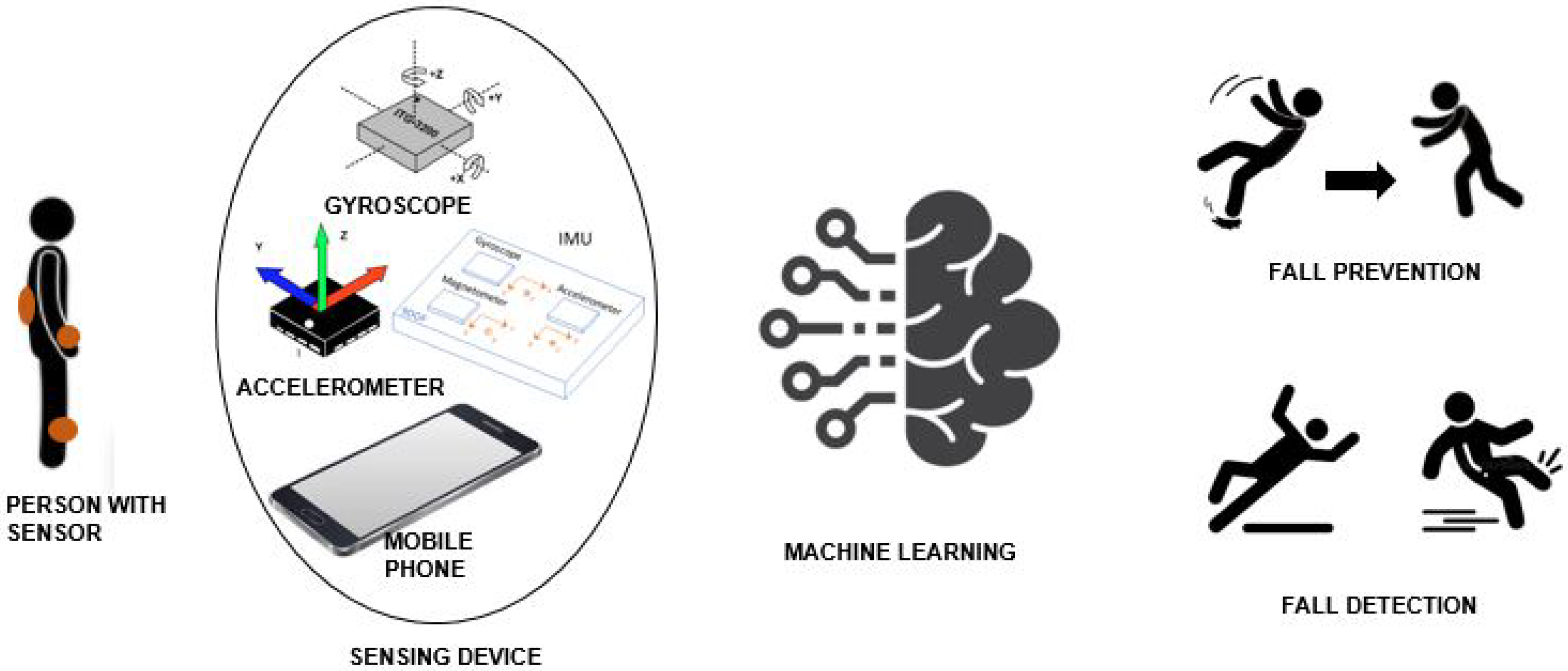

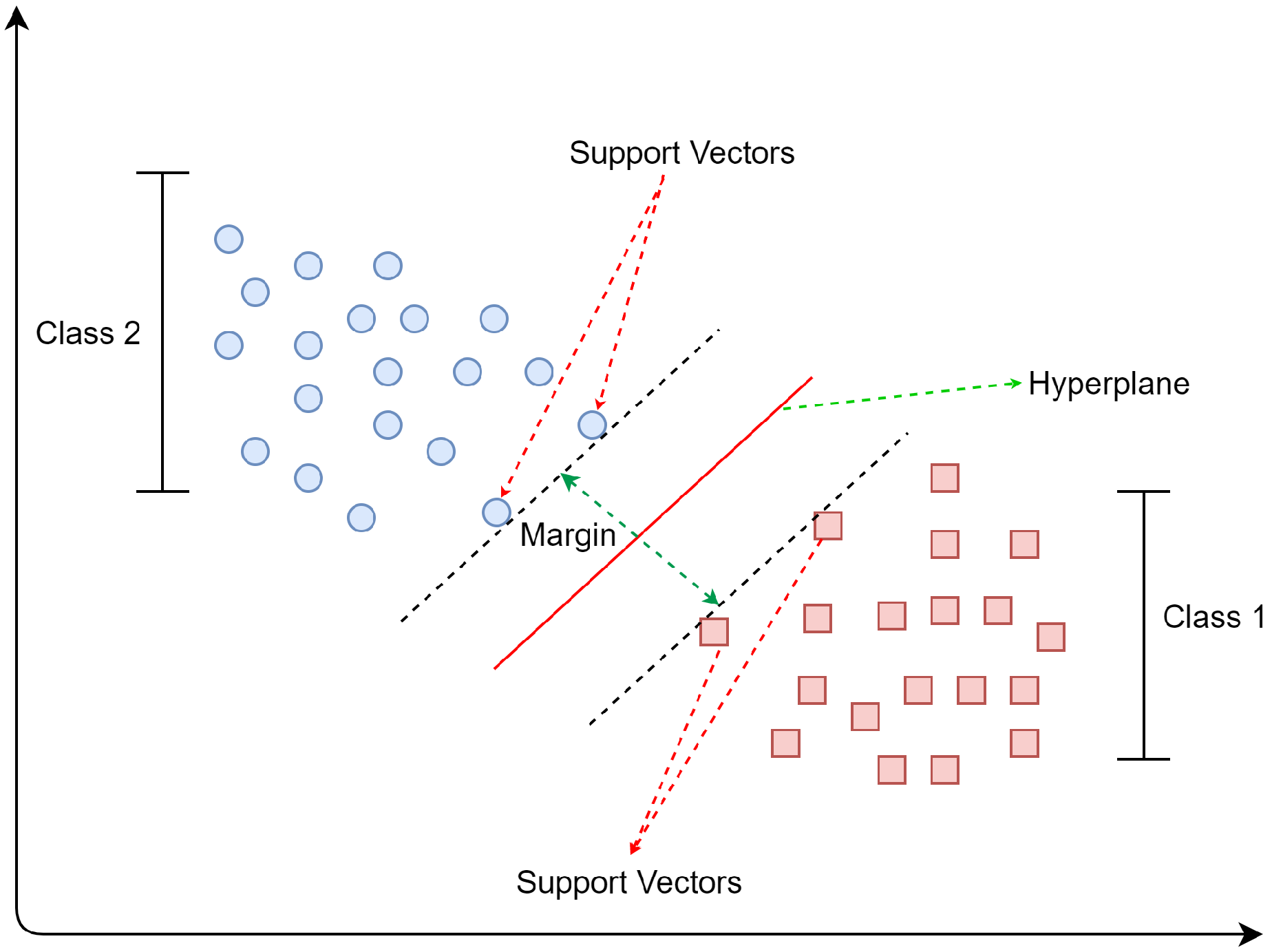
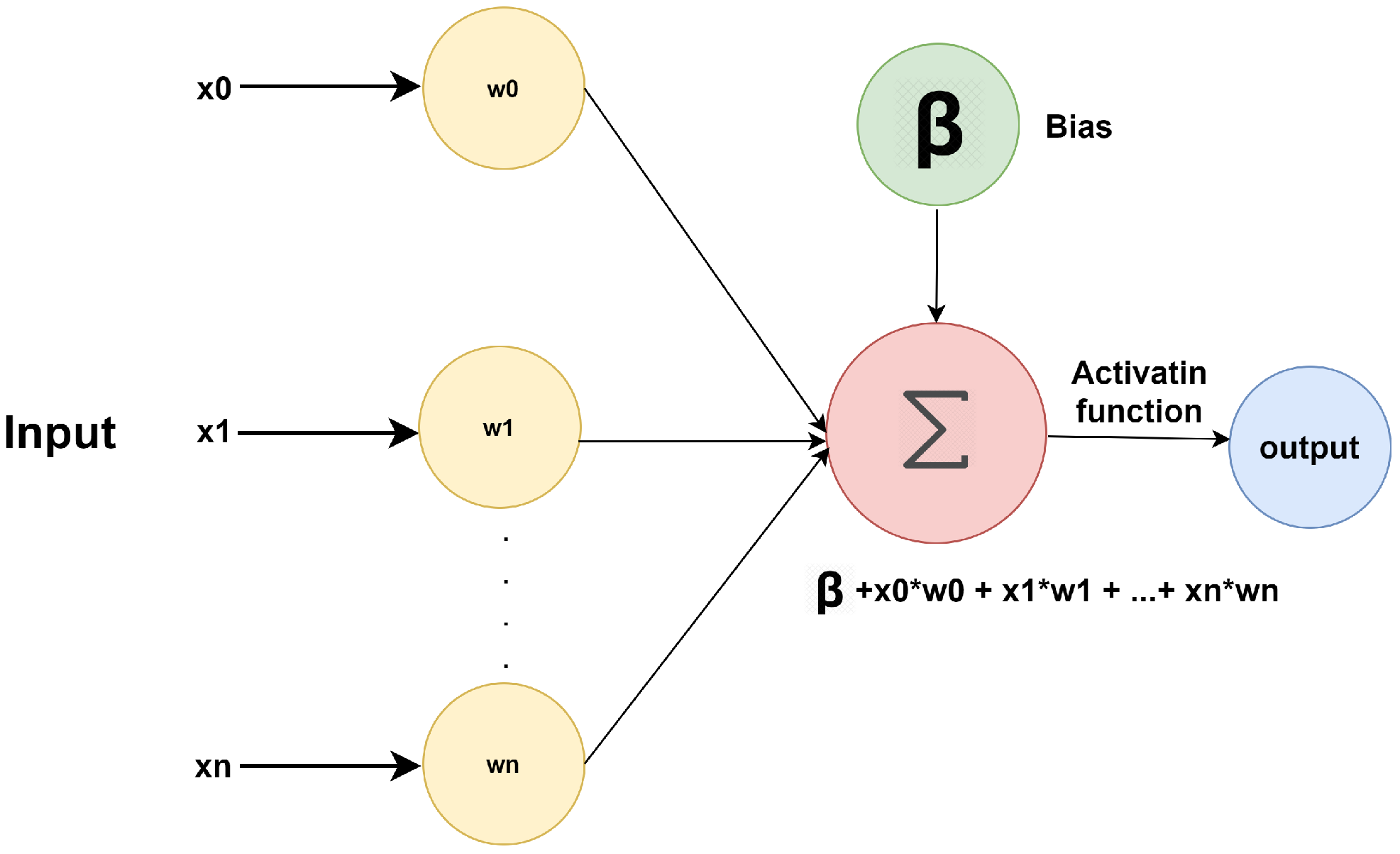

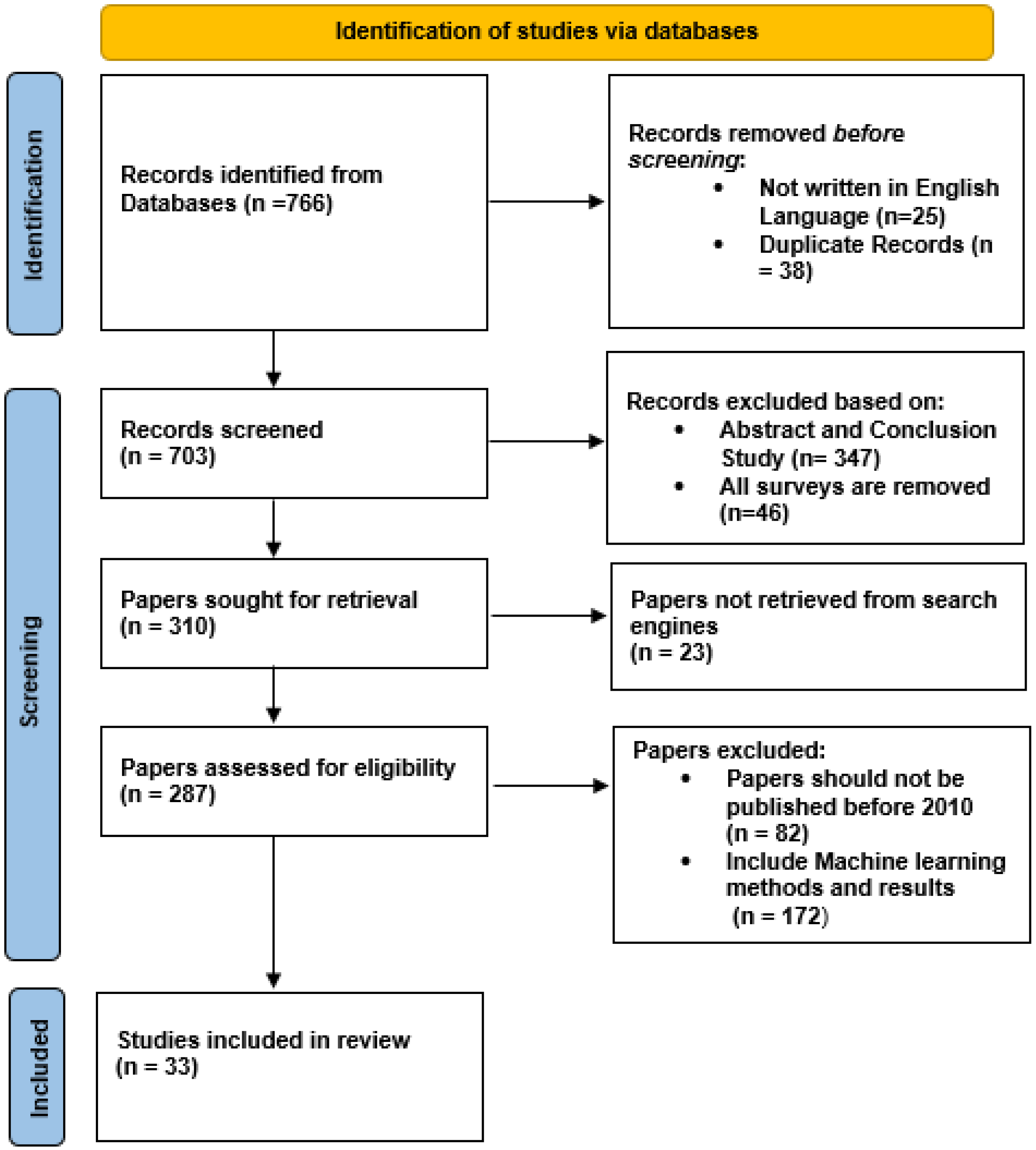
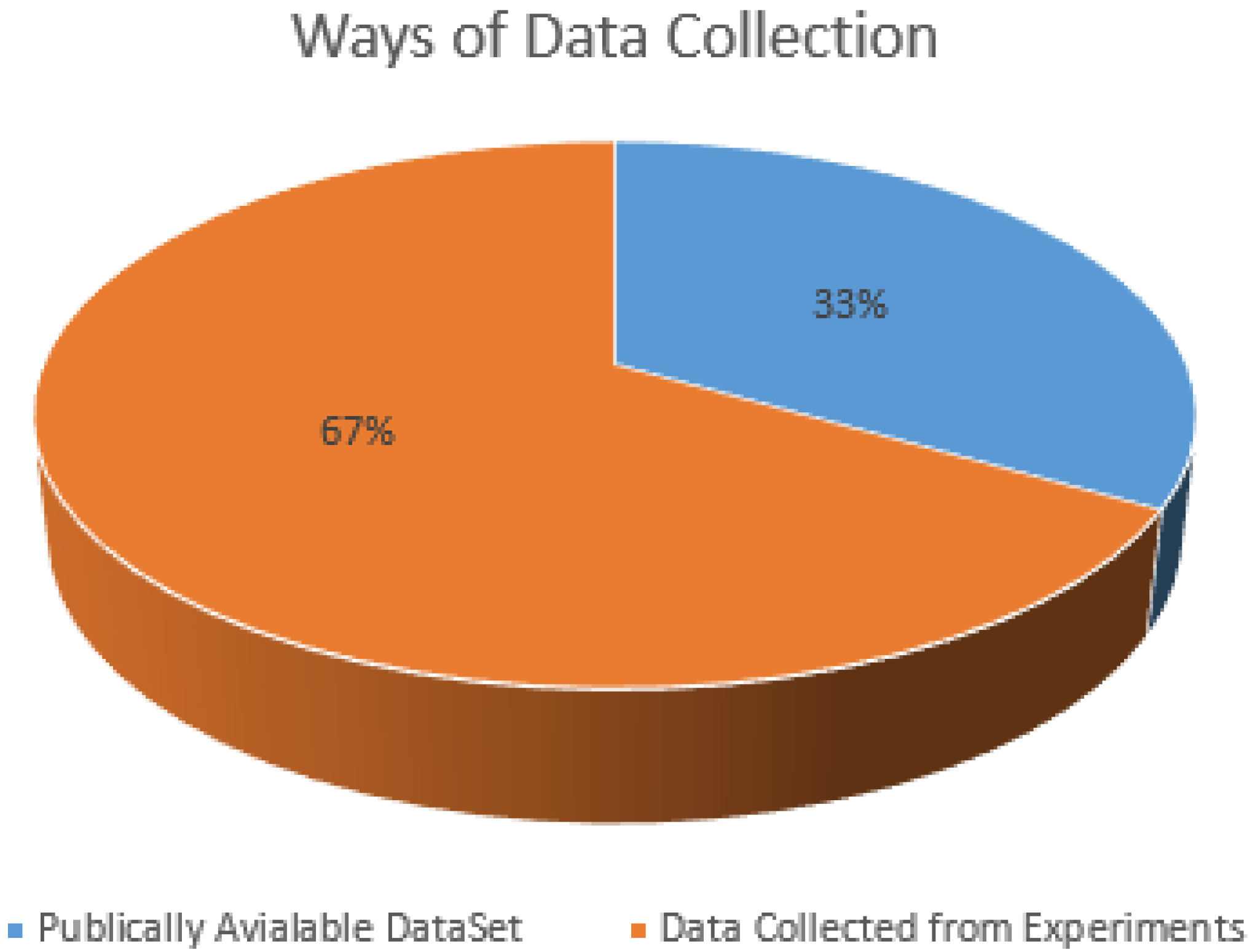
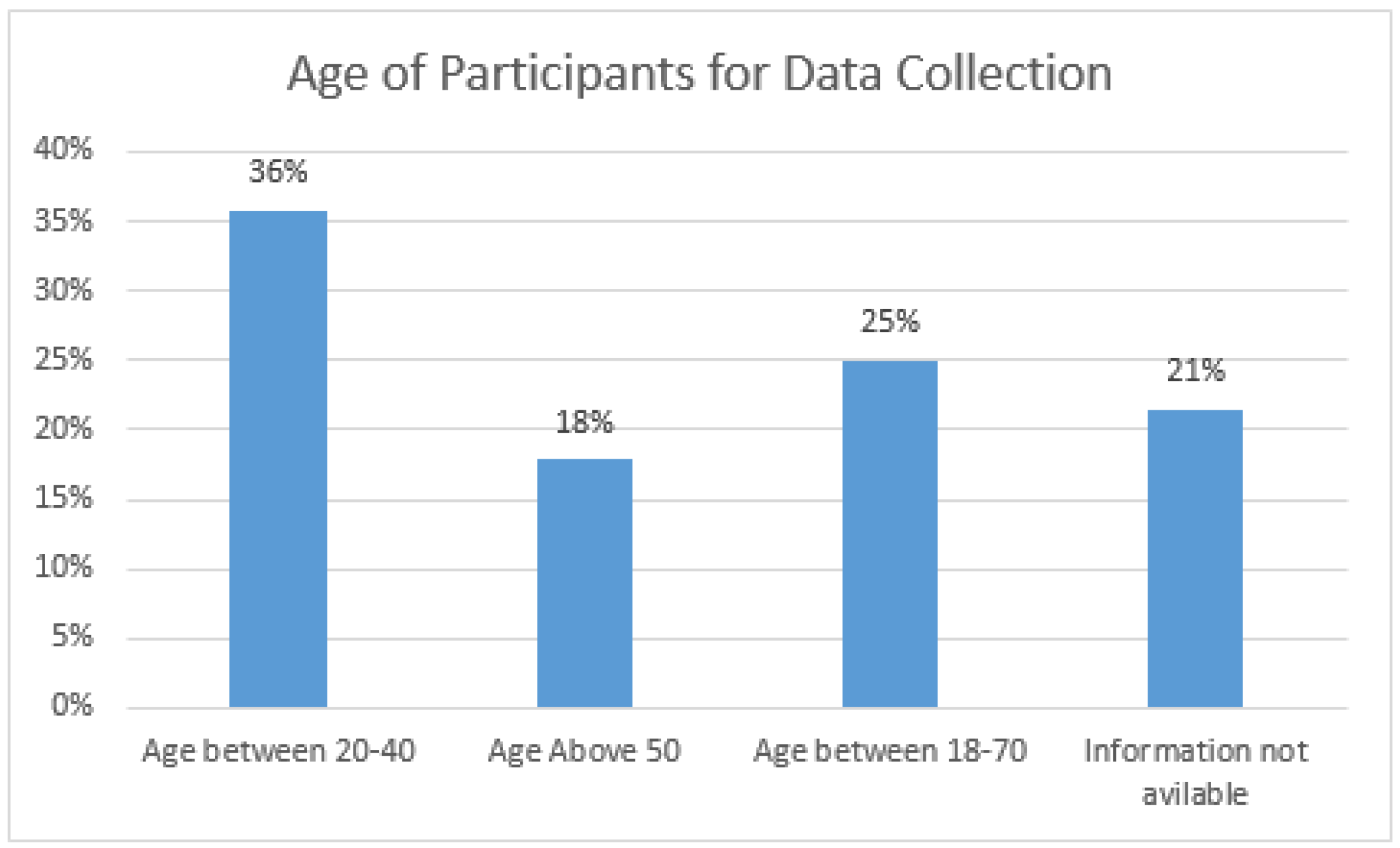
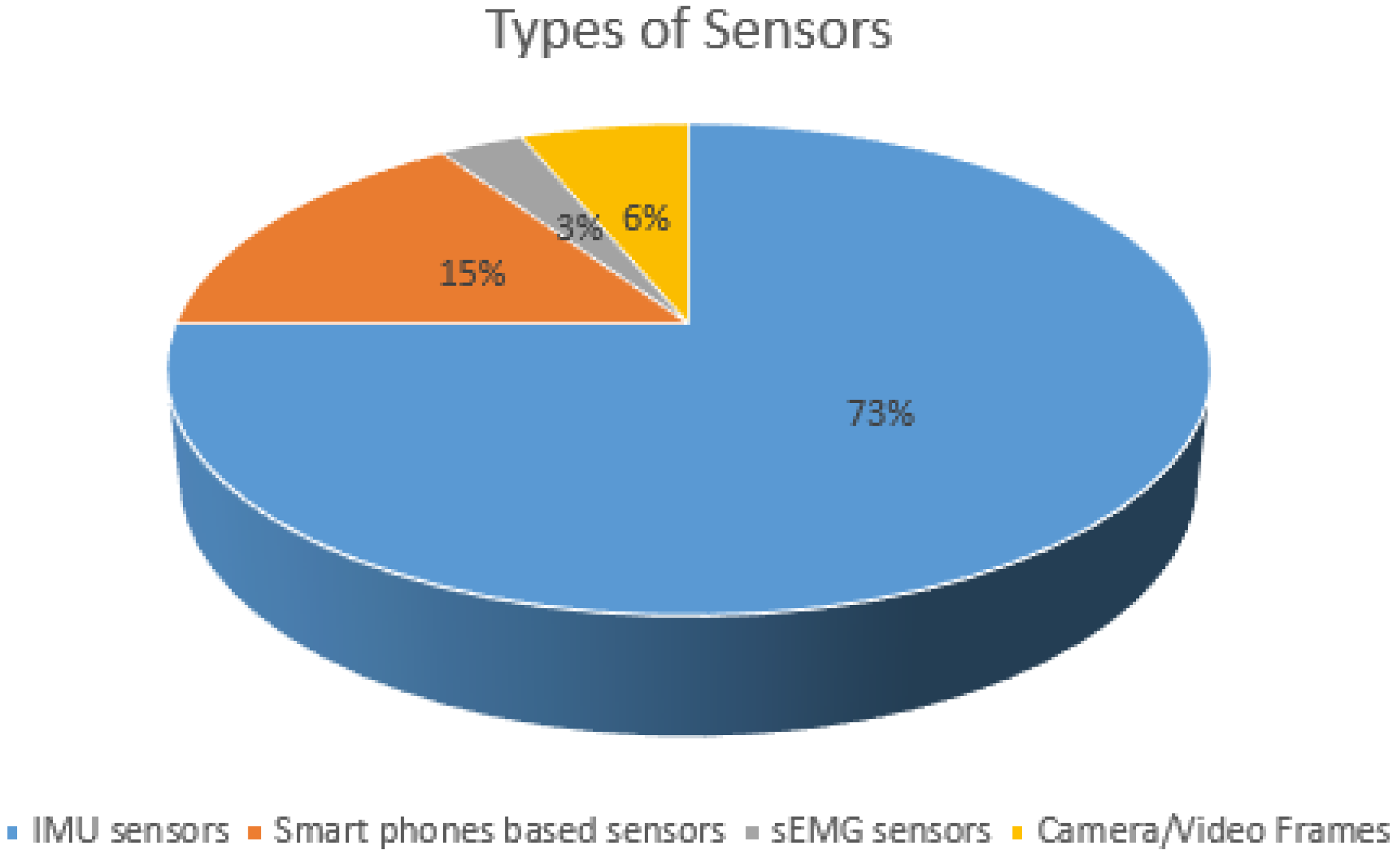
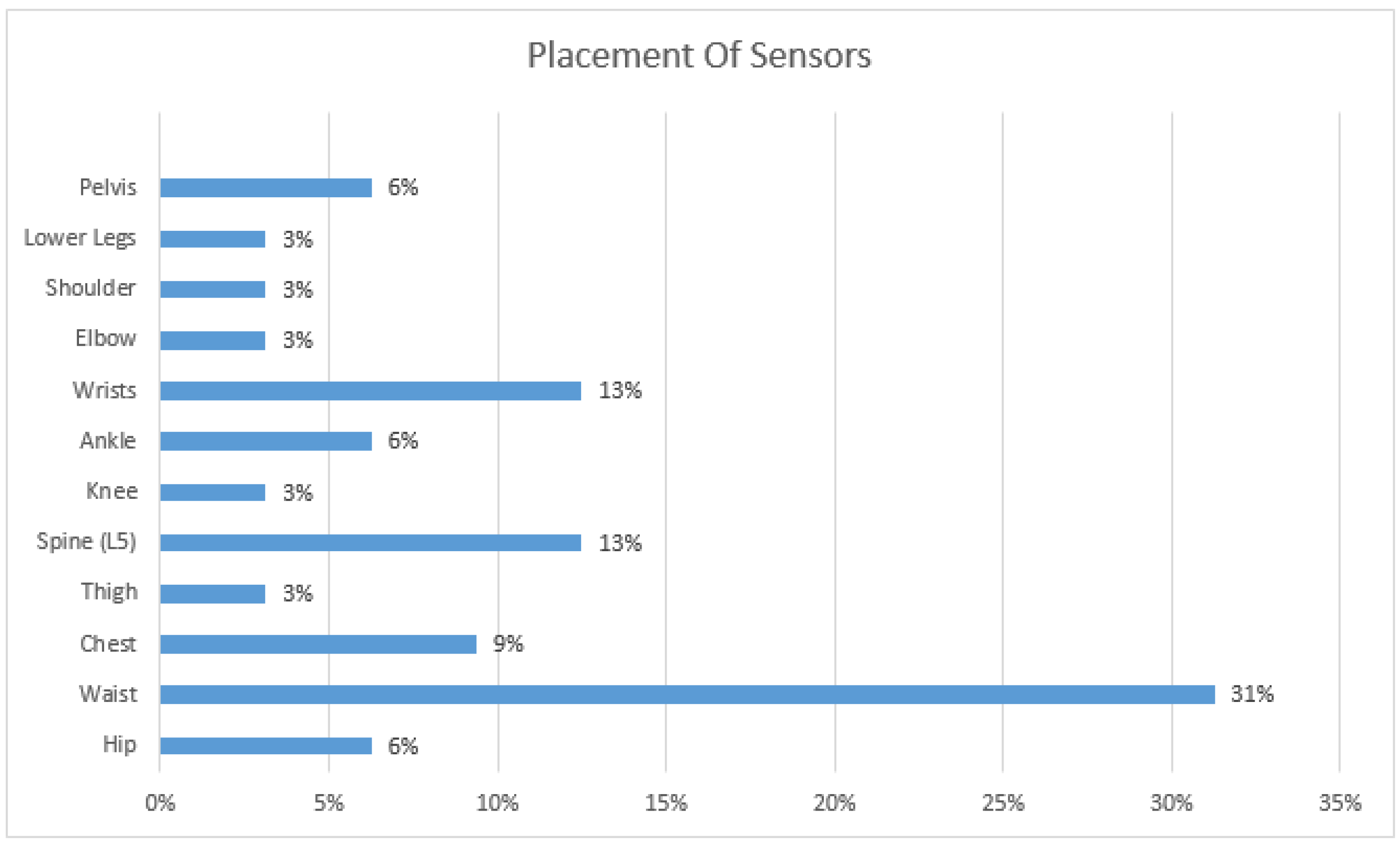
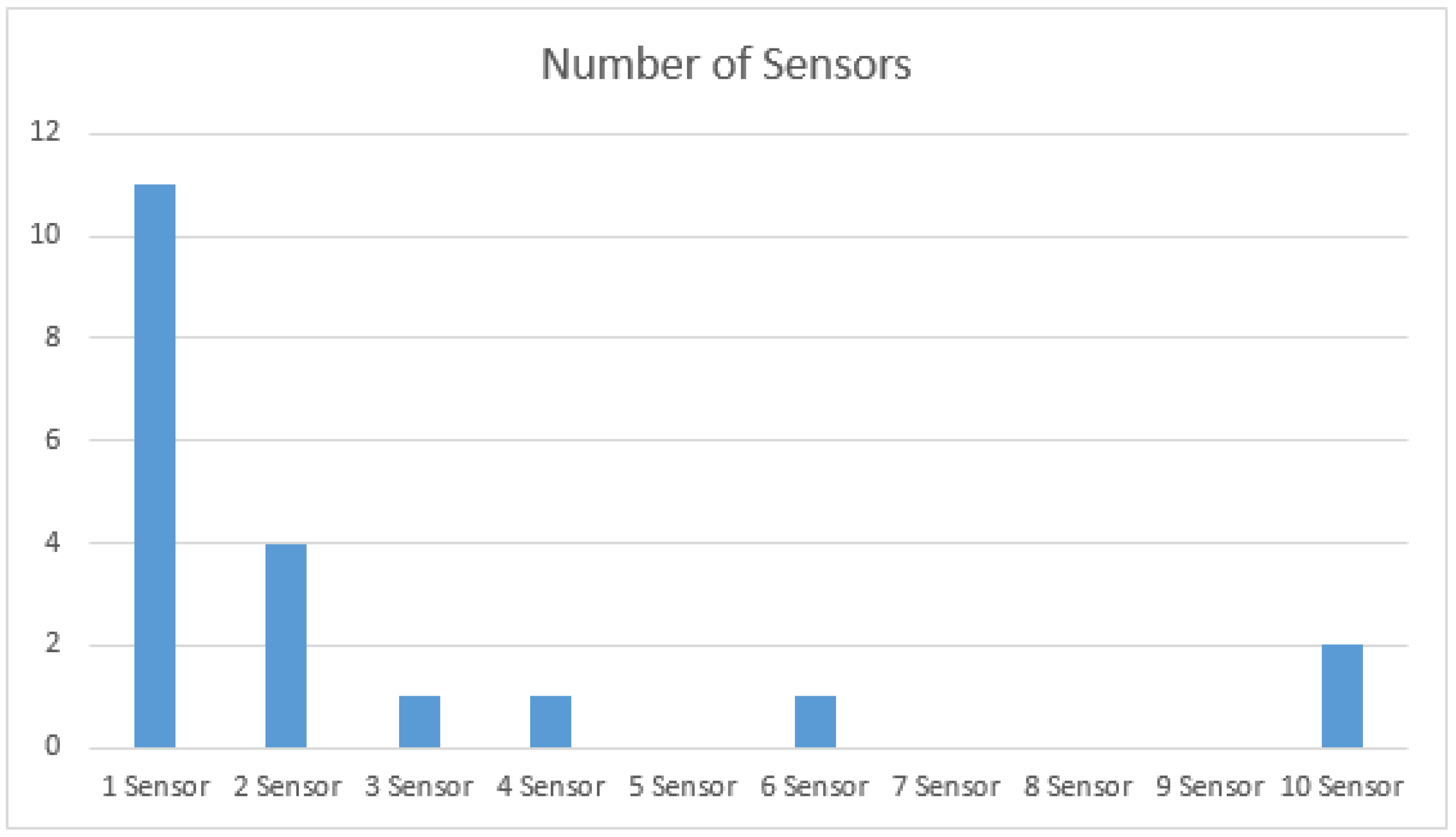
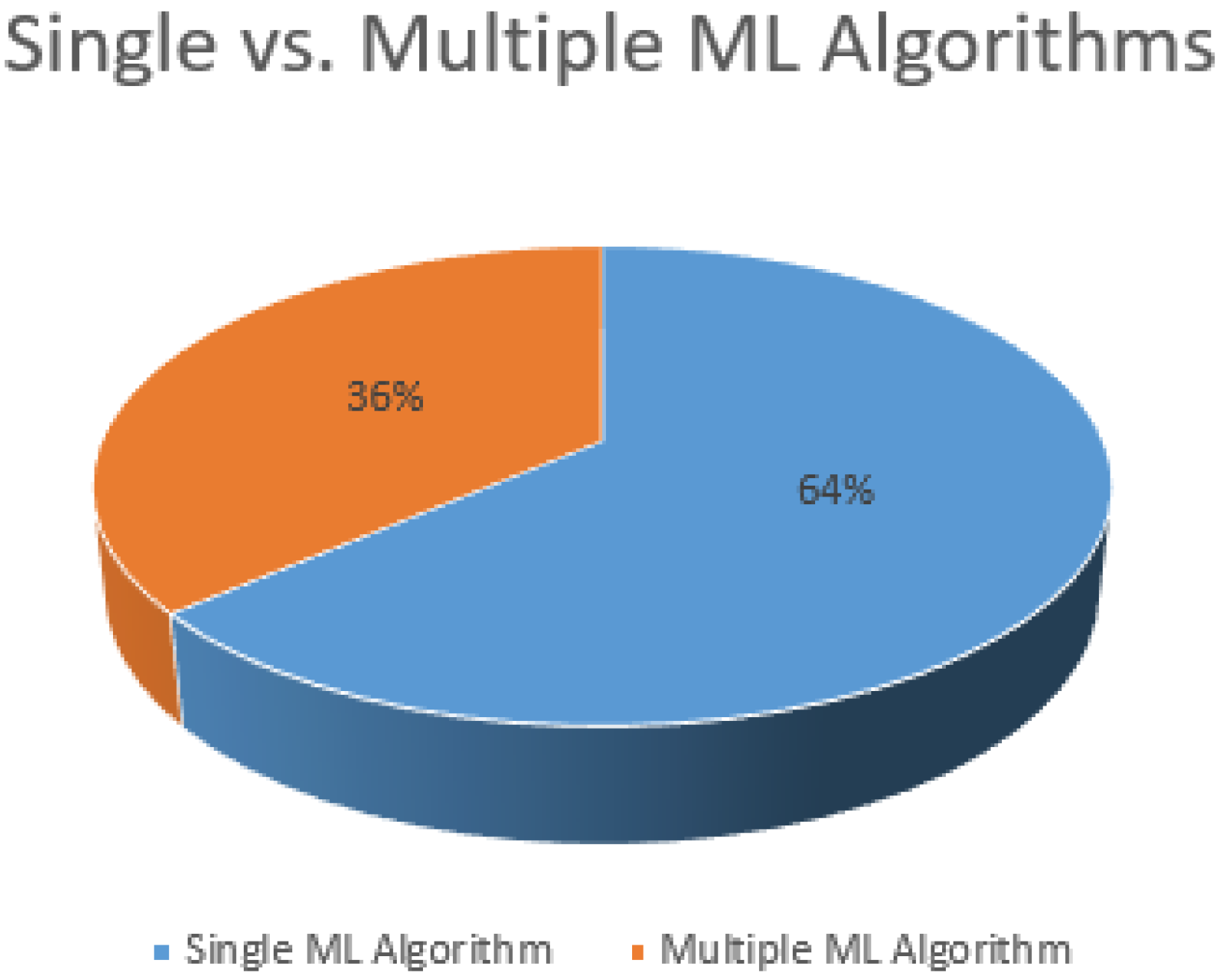

| Name of Sensor | Functionality |
|---|---|
| Accelerometer | Measures the rate of change of velocity (acceleration) of an object along its axis. |
| Gyroscope | Measures rotational changes concerning orientation. Hence, it calculates the angular velocity along three axes, pitch (x-axis), roll (y-axis), and yaw (z-axis) |
| Magnetometer | Measures the relative change of a magnetic field, its direction, and strength. |
| Inertial Measurement Unit (IMU) | Consists of an accelerometer, gyroscope, and magnetometer. It provides 2 to 6 degrees of freedom, which refers to different object movements in 3-dimensional space. |
| Surface Electromyography (sEMG) | It is used for detecting potentials using electrodes placed on the skin using electrochemical transducer [42]. |
| Academic Library | Search String |
|---|---|
| Google Scholar | ⇒ Fall detection using machine learning ⇒ Fall prevention using machine learning ⇒ Fall classification using machine learning ⇒ Machine learning for Fall Classification ⇒ Fall Detection and Prevention Using Machine Learning ⇒ Detecting Fall in Elderly Using Machine Learning |
| IEEE Xplore | ⇒ (((“All Metadata”:Fall Detection) AND “All Metadata”:(Machine Learning) //Filters Applied: 2010–2020 ⇒ (((“All Metadata”:Fall Prevention) AND “All Metadata”:Machine Learning) //Filters Applied: 2010–2020 ⇒ (((“All Metadata”:Fall Detection and Prevention) AND “All Metadata”:Machine Learning) //Filters Applied: 2010–2020 |
| Science Direct | ⇒Fall Detection Using Machine Learning. Limited to research articles, conference abstracts. ⇒Fall Prevention Using Machine Learning Limited to research articles, conference abstracts. ⇒Fall Classification Using Machine Learning Limited to research articles, conference abstracts. |
| ML Algo | Sensor | Sensor Placement | Accuracy | Sensitivity | Specificity | References |
|---|---|---|---|---|---|---|
| SVM | IMU | Waist | 98% | 100% | 100% | [46,52,53,85,86,87,88] |
| Wrist | 91.13% | 99% | NA | [50,89] | ||
| SmartPhone (IMU) | Waist | 97.80% | 99.50% | 95.20% | [39] | |
| Thigh | 91.70% | 95.80% | 88.00% | [39] | ||
| kNN | IMU | Wrist | 99% | 99% | NA | [89,90] |
| Waist | 99.78% | 100% | 99.91% | [89] | ||
| 5th lumbar vertebra and sacrum | 99.40% | NA | NA | [91] | ||
| ANN | IMU | Waist | 95.25% | 96.50% | 94.00% | [46,92] |
| SmartPhone (IMU) | Wrist | 92.96% | 99.45% | 100% | [93] | |
| IMU | L5 vertebra | 96.3% | NA | NA | [94] | |
| RF | IMU | Hip | 73.70% | 84% | NA | [95] |
| Lower legs, posterior pelvis | 77.30% | 66.10% | 84.70% | [96] | ||
| SmartPhone (IMU) | Hand | NA | 99% | 98% | [51] |
| Learning Outcomes Using ML Algorithms | |
|---|---|
| ML Algorithm | Learning Outcomes |
| SVM | - The pattern of a falling and standing person can have a wide margin around the hyperplane. It can easily distinguish fallers from non-fallers. - SVM does not suffer from overfitting and handles high-dimensional data effectively; that is the case of fall detection. - It is memory-efficient in nature that is optimal for wearables. |
| kNN | - It is faster and learns from the datasets at time of making real time predictions. Therefore, small change in input data have not much effect on the classification results. - As classifier adopts to new data points, it can be used for classifying fall detection and prevention in real time. - The systems may be computationally expensive because a lot of memory is required to store the training data. |
| ANN | - Neural networks have the ability to learn by themselves and not depend only on the input data. After learning from the initial inputs and their relationships, ANNs can infer results from unseen data, making the model generalized. Therefore, when we provide unseen input data, the network learns the fall and non-fall activities and predicts better results. - As neural networks learn from examples, it can be helpful in determining falls in real-time conditions when input data may differ from training data. |
| RF | - The benefit of RF is that it is fast and effective with larger data. Therefore, it is a good choice to observe the fall activities or irregular gait for fall prevention. - The results of RF change considerably with minor changes in data due to large tree structures. The human gait is very dynamic and tends to change abruptly. Therefore, it often results in low accuracy and precision, as shown in the studies. - It consumes high memory, which makes it less efficient for wearable devices. |
| Sensor Placement | Learning Outcomes |
| Waist | - As the center of gravity lies around the waist, body movements can be measured accurately. Use of an accelerometer enables easily detecting the linear movements of the body, while a gyroscope can identify the turns or movement around the axis. - Therefore, sensors placed on the waist can help in identifying gait irregularities and be useful for fall detection and prevention. - Generally, a belt or pouch is required to wear the sensor on the waist, which may not be optimal for daily usage. |
| Wrist | - Provides good wear time compliance. - Wrist accelerometers can detect multiple intensities of activities that can be helpful in fall classification. - However, sometimes, the movement of the wrist may cause false alarms for fall detection. - Sedentary behavior (walking or lying down etc.) can be estimated accurately by a wrist-worn accelerometer. - Wrist-based sensors cannot predict lower body movements, so they are not suitable for fall prevention systems requiring minor gait details. |
| Hip | - Hip-worn sensors are limited in collecting data for different body movements. - A hip angle is similar for different walking activities, which makes it not feasible for fall prevention. - In contrast, hip angle/sensors can be useful in detecting falls. |
| Thigh | - Sensors worn on thigh can detect specific gait angles, making them useful for fall detection and prevention applications. |
| Ref. | Year | ML Algorithm(s) | Sensor | Placement of Sensors | Target Area | Tool(s) |
|---|---|---|---|---|---|---|
| Salleh et al. [46] | 2020 | Nonlinear Auto Regression neural network (NARnet) | Invensense sensor | Waist | Fall Detection | NA |
| Kumar et al. [47] | 2019 | SVM | IMU | Hip | Fall Prevention | DART |
| Chelli et al. [97] | 2019 | KNN, ANN, QSVM, and EBT IMU | NA | NA | Fall Detection | NA |
| Dubois et al. [54] | 2019 | Clustering | Microsoft Kinect v2 sensor (camera) | In front at 2 cm distance | Fall Prevention | NA |
| Kim et al. [44] | 2019 | Multi class Pre-Impact Fall Detection Model | IMU | Left anterior iliac crest of the pelvis | Fall Detection | NA |
| Wang et al. [45] | 2019 | Multi-view ensemble learning with missing values (MELMV) | NA | NA | Fall Prevention | NA |
| Santos at el. [98] | 2019 | Convolutional Neural Network | Smart phone or smart watch | NA | Fall Detection | NA |
| Villar et al. [99] | 2019 | SAX TS representation together with the TF-IDF | 3DACC sensor | Wrist | Fall Detection | R Studio |
| Yacchirema et al. [100] | 2019 | DT, Ensemble, LR, Deepnets | IMU | NA | Fall Detection | NA |
| Hua et al. [95] | 2018 | Random Forest | IMU | Hip | Fall Detection | STEADI |
| Shahzad et al. [39] | 2018 | SVM | Mobile Phone | Waist, thigh | Fall Detection | MKL_SVM |
| Putra et al. [101] | 2018 | EvenT-ML | Shimmer sensors | Chest, Waist | Fall Detection | NA |
| de Quadros et al. [90] | 2018 | KNN, DT, SVM, LR, LDA | GY-80 IMU device | Wrist | Fall Detection | NA |
| Hussain et al. [86] | 2019 | DT, LR, KNN, SVM classifier with Quadratic kernel function. | IMU | Waist | Fall Detection | MATLAB |
| Hsieh et al. [87] | 2018 | SVM with RBF Kernel function | IMU | Waist | Fall Prevention | NA |
| Aicha et al. [92] | 2018 | Combines convolutional and recurrent models (ConvLSTM) | IMU | Lower Back | Fall risk | NA |
| Rescio et al. [102] | 2018 | LDA | sEMG | Lower limb (Gastrocnemius and Tibilias muscles) | Fall Detection | MATLAB |
| Rodrigues et al. [91] | 2018 | SVM, Boosted and bagged DT, kNN, k-mean, Hidden Markov models | IMU | 5th lumbar vertebra and sacrum | Fall Detection | MATLAB |
| Saleh et al. [52] | 2019 | Two SVM combined | IMU | Waist | Fall Detection | NA |
| Serpen et al. [103] | 2018 | Random Forest, SVM | SHIMMER | Chest, thigh | Fall Detection, | NA |
| Hu et al. [29] | 2018 | Deep learning network (LSTM) | IMU | L5 vertebra | Fall Detection | Python |
| Mauldin et al. [93] | 2018 | NB, SVM, Deep Learning | Smart watch | Wrists | Fall Detection | NA |
| Drover et al. [96] | 2017 | Random Forest Classifier | IMU | Lower legs (left and right lateral shanks), posterior pelvis | Fall Detection | MATLAB |
| Fan et al. [104] | 2017 | Directed Acyclic Graph Support Vector Machine (DAGSVM) | NA | Video frames | Fall Detection | NA |
| Shawen et al. [51] | 2017 | Random forest, SVM, Gradient boosting, wXtreme Gradient Boosting (XGBoost) | Mobile Phones (Samsung Galaxy S4) | Waist, in a pocket, hand | Fall Detection | MATLAB and Python |
| Hsieh et al. [105] | 2016 | SVM, kNN | IMU | Wearable sensor | Fall Detection | NA |
| Bourke, et al. [9] | 2016 | DT | IMU | L5 (fifth lumbar spine) | Fall Detection | Matlab, Weka |
| Chen et al. [53] | 2015 | SVM | IMU | Waist | Fall Detection | NA |
| Özdemir et al. [89] | 2014 | kNN, LSM, SVM, Bayesian Decision Making (BDM), DTW, ANN | IMU | Head, chest, waist, right wrist, right thigh, and right ankle | Fall Detection | NA |
| Aziz et al. [85] | 2014 | SVM | Inertial sensor | Waist | Fall Detection | Matlab |
| Albert et al. [106] | 2012 | SVM, LR, Naïve Bayes, Class reg tree, KNN | Mobile phones | Attached on belt and centred at the back | Fall Detection | MATLAB |
| Caby et al. [50] | 2010 | A radial basis function network classifier, SVM, KNN, Naive bayesian | NA | Knee, ankle, wrists, elbow, shoulder (both left and right) | Fall Detection | NA |
| Shan et al. [88] | 2010 | SVM | IMU | Waist | Fall Detection | MATLAB |
Publisher’s Note: MDPI stays neutral with regard to jurisdictional claims in published maps and institutional affiliations. |
© 2021 by the authors. Licensee MDPI, Basel, Switzerland. This article is an open access article distributed under the terms and conditions of the Creative Commons Attribution (CC BY) license (https://creativecommons.org/licenses/by/4.0/).
Share and Cite
Usmani, S.; Saboor, A.; Haris, M.; Khan, M.A.; Park, H. Latest Research Trends in Fall Detection and Prevention Using Machine Learning: A Systematic Review. Sensors 2021, 21, 5134. https://doi.org/10.3390/s21155134
Usmani S, Saboor A, Haris M, Khan MA, Park H. Latest Research Trends in Fall Detection and Prevention Using Machine Learning: A Systematic Review. Sensors. 2021; 21(15):5134. https://doi.org/10.3390/s21155134
Chicago/Turabian StyleUsmani, Sara, Abdul Saboor, Muhammad Haris, Muneeb A. Khan, and Heemin Park. 2021. "Latest Research Trends in Fall Detection and Prevention Using Machine Learning: A Systematic Review" Sensors 21, no. 15: 5134. https://doi.org/10.3390/s21155134





